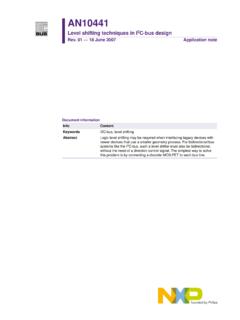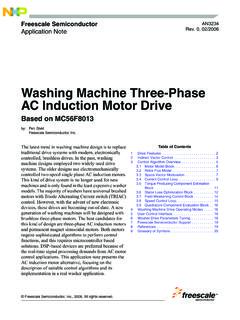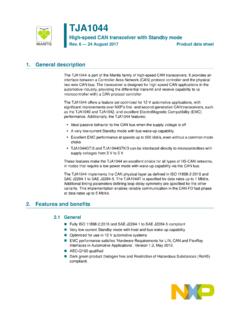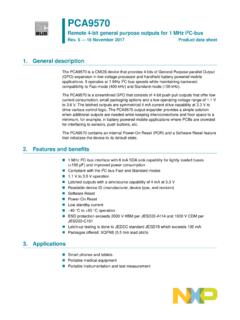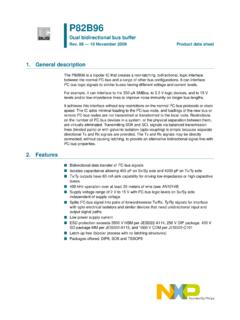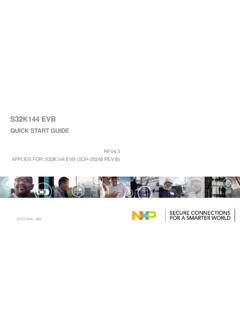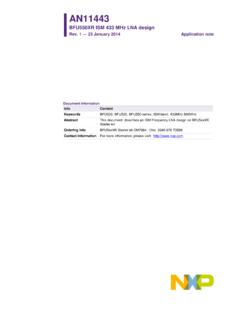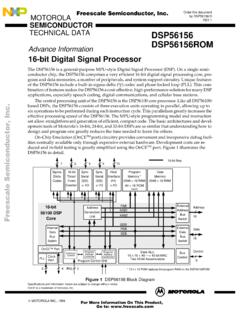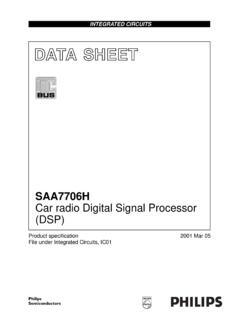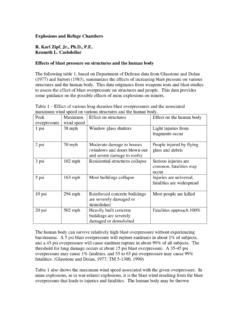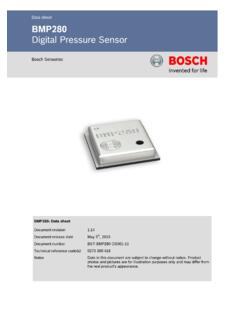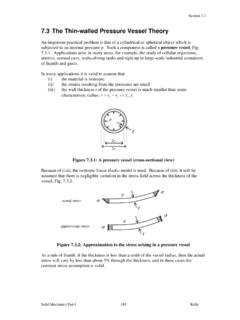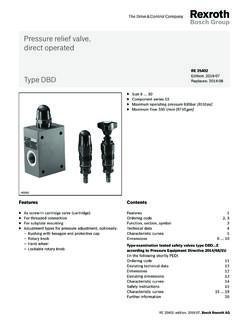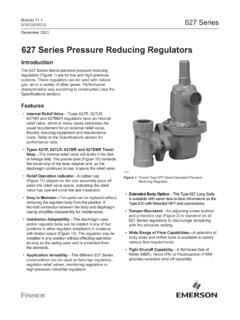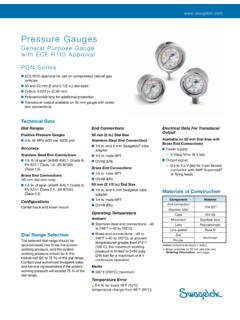Transcription of Blood Pressure Monitor - Fundamentals and Design
1 1 IntroductionThis application note demonstrates the implementation of abasic Blood Pressure Monitor using Freescale products. Theblood Pressure Monitor can be implemented using any of theFreescale medical oriented MCUs: Kinetis MK53N512 andFlexis MM members MC9S08MM128 and MCF51MM256embedding a 16-bit ADC, 12-bit DAC, 2 Programmable-GainOp-Amps, 2 TRIAMPS, Analog Comparators, and Vrefgenerator. The K50 family can also perform DSP instructionsfor signal treatment and MCF51MM can perform multiply andaccumulate (MAC) document is intended to be used by biomedical engineers,medical equipment developers, or any person related with thepractice of medicine and interested in understanding theoperation of Blood Pressure monitors.
2 Nevertheless, it isnecessary to know Fundamentals of electronic, analog, anddigital pressurefundamentalsThis section contains information about physiologicalconcepts of arterial Pressure and Blood Pressure monitoroperating SemiconductorDocument Number:AN4328 Application NoteRev. 2, 12/2012 Blood Pressure MonitorFundamentals and Designby:Santiago Lopez 2012 Freescale Semiconductor, Pressure Pressure Blood Pressure Monitor pressureArterial Pressure is defined as the hydrostatic Pressure exerted by the Blood over the arteries as a result of the heart leftventricle contraction.
3 Systolic arterial Pressure is the higher Blood Pressure reached by the arteries during systole (ventricularcontraction), and diastolic arterial Pressure is the lowest Blood Pressure reached during diastole (ventricular relaxation). In ahealthy young adult at rest, systolic arterial Pressure is around 110 mmHg and diastolic arterial Pressure is around 70 flow is the Blood volume that flows through any tissue in a determined period of time (typically represented as ml/min)in order to bring tissue oxygen and nutrients transported in Blood .
4 Blood flow is directly affected by the Blood Pressure asblood flows from the area with more Pressure to the area with less Pressure . Greater the Pressure difference, higher is theblood flow. Blood is pumped from the left ventricle of the heart out to the aorta where it reaches its higher Pressure Pressure falls as Blood moves away from the left ventricle until it reaches 0 mm Hg, when it returns to the heart s rightatrium. Figure 1 represents Pressure 1. Pressure changes on Blood Pressure Monitor operating principleBlood Pressure Monitor operation is based on the oscillometric method.
5 This method takes advantage of the pressurepulsations taken during measurements. An occluding cuff is placed on the left arm and is connected to an air pump and apressure sensor. Cuff is inflated until a Pressure greater than the typical systolic value is reached, then the cuff is slowlydeflated. As the cuff deflates, when systolic Pressure value approaches, pulsations start to appear. These pulsations representthe Pressure changes due to heart ventricle contraction and can be used to calculate the heartbeat rate.
6 Pulsations grow inamplitude until mean arterial Pressure (MAP) is reached, then decrease until they disappear. Figure 2 shows the cuff pressurevs. Pressure fundamentalsBlood Pressure Monitor Fundamentals and Design , Rev. 2, 12/20122 Freescale Semiconductor, 2. Cuff Pressure vs. heartbeat signalOscillometric method determines the MAP by taking the cuff Pressure when the pulse with the largest amplitude and diastolic values are calculated using algorithms that vary among different medical equipment Blood Pressure Monitor calculates the systolic and diastolic Pressure by considering that systolic Pressure isapproximately equal to the Pressure measurement taken in the cuff when a pulse with 70% of the amplitude of the MAP pulseappears while the cuff Pressure is above the MAP
7 Value. Diastolic Pressure is approximately equal to the cuff Pressure valueregistered when a pulse with 50% of the MAP pulse amplitude appears while the cuff Pressure is under the MAP Pressure Monitor implementationBlood Pressure Monitor is implemented using Freescale medical-oriented Kinetis K53 MCUs and Flexis MM devices, whichfeature the following characteristics: 16-bit ADC 12-bit DAC 2x programmable gain operational amplifiers (OpAmps) 2x transimpendance amplifiers (TRIAMPS) Vref generator Set of DSP instructions including MAC (Only K5X Family) Multiply and Accumulate (MAC) instruction on MCF51 MMFreescale medical-oriented MCUs reduce the Bill Of Materials (BOM) required for medical applications and provide greatprocessing capabilities ideal for medical equipment.
8 Nevertheless, some external circuitry is needed for Pressure sensing andcuff analog front endMED-BPM Analog Front End (AFE) is a demo board designed for work as a Blood Pressure Monitor in conjunction with aFreescale medical-oriented MCU. MED-BPM communicates with the MCU using the medical connector, and allows for easyprototyping and reduced time to market by using the Freescale Tower System. MED-BPM block diagram is shown below(MED-BPM analog front end). Blood Pressure Monitor implementationBlood Pressure Monitor Fundamentals and Design , Rev.
9 2, 12/2012 Freescale Semiconductor, 3. MED-BPM block connectorThe medical connector is a standard connector in Freescale medical-oriented boards (TWR-9S08MM, TWR-MCF51MM andTWR-K53). This connector includes the most important analog peripherals for medical applications and an I2C channel forcommunication. The following table describes medical connector 1. Medical connector signals1 VCC ( )VSS (GND)23I2C SDAI2C SCL / PWM45 ADC Differential CH +ADC Differential CH -67 ADC Single Ended CHDAC Out89Op-Amp 1 OutOp-Amp 2 Out1011Op-Amp 1 Input -Op-Amp 2 Input -1213Op-Amp 1 Input +Op-Amp 2 Input +1415 TRIAMP 1 Input +TRIAMP 2 Input +1617 TRIAMP 1 Input -TRIAMP 2 Input -18 Table continues on the next Pressure Monitor implementationBlood Pressure Monitor Fundamentals and Design , Rev.
10 2, 12/20124 Freescale Semiconductor, 1. Medical connector signals (continued)19 TRIAMP 1 OutTRIAMP 2 cuff Pressure controlMED-BPM works using an oscillometric method for Blood Pressure measurements. This is a noninvasive method whichrequires an external arm cuff in order to occlude the patient s arm and detect the systolic and diastolic arterial Pressure . Thearm cuff is inflated using an external air pump controlled with an MCU GPIO pin, and deflated by activating an escape valvewith another GPIO the current provided by the USB port (500 mA) is not enough to activate the air pump and the valve (600 mA), thoseexternal components are activated by using an external power source which provides sufficient current.
